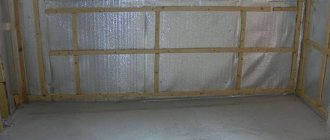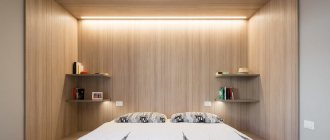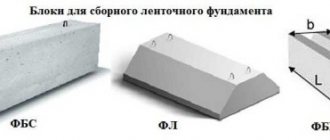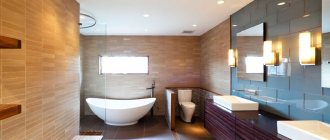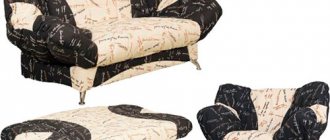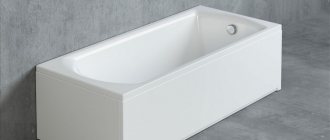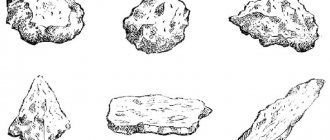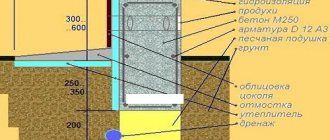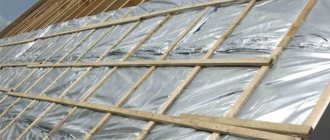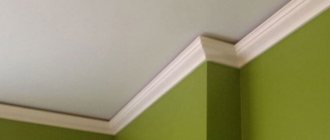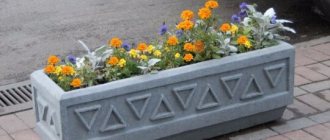Mixborber
It is an elongated flower bed. Typically, such flowering beds are located near buildings and fences. Very often they are used to separate zones of a site.
Plants can be very different in height, but low-growing flowers are planted in the foreground. However, this is a general rule for planting flowers.
raised flower bed
Raised flower beds are becoming increasingly popular. They are placed not on the surface of the earth, but in any container that is raised to a height.
Such flower beds look great on stairs and verandas and create an interesting design in the garden.
Their small size and raised position make them easier to care for. They just require more watering.
Plants living in such flower beds are not at risk of frost on the soil, and pests are less bothered by such flower beds.
Annuals are mainly used as flowering plants. Perennial plants can freeze in winter.
Annual flowers for a simple flower bed
First of all, when organizing a simple flower bed, you should pay attention to the fact that all ornamental plants have various life forms. There are annual flowers that need to be re-sown every year.
There are biennials that bloom only in the second year of life. There are also perennial plants, blooming brighter and more magnificently every year.
If you plant plants from seeds to create a simple and beautiful flower bed, then only annual plants will be able to bloom this year. Some of them begin to bloom only after 13 – 15 weeks. These species include late asters, tall marigolds, verbena, salvia, petunia, and lobelia.
These flowers can only be grown through seedlings, while other annuals can be safely planted directly into the ground.
For example:
- dahlias;
- marigold;
- matthiol;
- calendula;
- poppy;
- nastrutia;
- Drummond's phlox
- Eschscholzia;
- cornflower.
The above plants can be sown in early or mid-May, and you can see their beautiful flowering already in July-August. The decorative properties of annual plants appear only in the second half of summer.
It is worth noting that growing flowers through seedlings significantly speeds up their flowering time. And planting ready-made sprouts in a flowerbed is somewhat more pleasant than waiting for shoots to emerge.
Vertical flower bed
A vertical flower bed will be an interesting design for a garden plot. This design of the flowerbed will not only be the highlight of the garden, but will also help save space for growing more useful crops.
This design will allow you to elegantly decorate the unassuming walls of barns, give gazebos the charm of a green building, and shade structures from the bright sun and prying eyes.
Vertical flower beds located on shaped frames will give the site an unusual look. These can be balls, triangles, animal figures.
Begonia, petunia, and all hanging and climbing plants can be used as plantings.
How to make a multi-tiered flower bed
Another type of spectacular planting at the dacha is a multi-tiered flower bed for growing hanging plants. You can create it from suitable containers of different shapes, ready-made shapes, tires, boards, stone, even broken furniture. The main condition is that the plantings should be arranged in tiers, one above the other.
Popular articles Happy Easter greetings in verse
- First, the area for the flower bed is prepared.
- The first tier is being built. It should be the strongest and most stable - it will bear the weight of the entire structure.
- The next tiers are installed one above the other so that there is space left to fill with soil.
- Selected plants are planted in the resulting “pockets” of soil.
- A multi-tiered flower bed is watered in stages, starting from the very top.
Numerous photos of flower beds at the dacha fill the Internet. From there you can get a lot of ideas or come up with your own unique options.
Ring flower bed
Do-it-yourself flower beds and flower beds in the form of a ring gracefully encircle trees, sculptures, gazebos, and other decorative elements.
Often large flowerpots with flowers are placed in the center of such a composition. Low-growing plantings are chosen as inhabitants of the ring flower bed.
How to properly fill a flowerbed with wood chips
To fill the area with wood chips over a longer period of time, it should be laid on a layer of agrospan (covering material). In this form, you will need 3-4 cm of wood chips. In the absence of covering material, the thickness of the chip layer must be doubled. To give freshness to the area, the wood chips should be renewed every season, replacing the top layer. The lower one will rot over time, fertilizing the soil.
In conclusion, we can say that designing a garden yourself is a fascinating process. However, it requires careful preparation, starting from choosing a style and taking measurements, to drawing up flower arrangements based on the existing features of the terrain and climate.
0 0 votes
Article rating
Rules for selecting plants
Flowerbeds are laid out in an open place where all flowers receive an even amount of light and water.
Tall plants are planted in the center of the composition, on the far edge or in the corners of the flower garden.
The enclosing flower border should be different in color from the main flower bed.
Perennial plantings will take up a lot of space over time, so they need to be planted quite far from each other, and at first the gaps between them will be perfectly covered by annuals.
For flower bed frames, it is recommended to purchase flowers with a low growth rate.
The ideal flower garden will be a structure that will bloom all summer. To do this, flowers are planted in it, which will gradually replace each other.
When planting, you should take into account the preferences of plants, and place in one place those flowers that will need the same watering, light, and fertilizer.
You should know that some plants will perfectly complement each other, and some (loosestrife, periwinkle) will quickly “kill” their less tenacious neighbors.
Do-it-yourself photos of flower beds will help you decide on the choice of green or blooming flower garden residents.
Flowerbeds: details and details
We found out what a flower bed is and how it differs from other types of flower beds (Flower beds and flower beds - what is the difference?) This time I would like to talk in more detail about what flower beds are.
After all, this type of flower garden does not become obsolete and does not go out of garden fashion, no matter what new trends appear. To begin with, it’s probably worth deciding on the type of flowerbed depending on its location. Traditionally, there are central and side flower beds. Since the central one attracts more attention, it is usually made more elegant, ceremonial, and solemn. The flowerbed can be located almost anywhere on the site: at the entrance, in front of the facade of the building, in the middle of the lawn, in a tree trunk, near the fence - or simply wherever it is convenient for you and where you see fit. Only, depending on the location, it is important to choose the right size and shape, as well as the plants for planting.
It is not worth making large flower beds even in large areas - they are simply inconvenient to care for. In this case, it is better to decorate several flower beds, creating an original composition from them. For example, like this:
It is believed that for a round flower bed the maximum convenient diameter is 2 meters. But it doesn’t have to be round in shape. Flower beds can be square, rectangular, oval, or figured. Volumetric flower beds made in the shape of various figures are exceptionally decorative. They are built on special frames, and very few people are probably able to build such a flower garden on a summer cottage, but in parks these compositions invariably evoke the admiration of spectators.
And at the dacha, you can use a simpler option: make some simple or, conversely, intricate design from flowers. In this case, as a rule, low-growing plants are used, identical in height, so that the pattern is clearly visible. This type of flower bed is called carpet. Large carpet flower beds are usually arranged in the front areas of parks, using dwarf decorative foliage and ground cover plants that consistently maintain their decorative appearance throughout the season. The floral pattern here can be very complex; Often he repeats the designs of real carpets. Such flower beds look absolutely fantastic, but they are very labor-intensive. But this, for example, option can easily be repeated on your site:
Continuing the conversation about the shape of the flowerbed, one cannot ignore its framing. Flowerbeds are rarely left without an edge, as a rule, only on lawns, where green grass itself serves as the border of the flower bed, emphasizing its shape. In other cases, all kinds of materials are used to shape the contours and separate the flower garden from the surrounding space. In this case, raised flower beds of varying heights are often formed. Popular materials for fencing flower beds include natural stone, brick, wood; Nowadays, ready-made plastic fencing is very common, relatively inexpensive and very convenient.
Here is an example of the original use of gabion mesh when creating a flower bed - an option that is quite affordable and very interesting:
We’ll talk more about how to make a flowerbed at the dacha with your own hands next time, but for now let’s return to what other modern flowerbeds are like.
Flowerbeds in flowerpots and containers are a very convenient option not only for urban decoration, but also for summer cottages. Their advantage is mobility: a small container can be installed anywhere, and can be easily moved if desired and necessary. It is easy to care for such a flower bed. But let me remind you once again: plants planted in a container require moisture more often, so those who are at the dacha only on weekends will have to take care of some additional sources for their plants. A good solution is to add hydrogel to the soil when planting, the granules of which retain moisture and release it to the plants as needed. And another important nuance: be sure to provide holes for the drainage of excess water and good drainage at the bottom of the flowerpot, otherwise the very first heavy rain will turn it into a small swamp.
Flowerpots and containers can be made from any available material - there are no restrictions, only your imagination.
I can’t ignore such an original option as a potted bed. Of course, this is more of a city idea than a country idea, but in my opinion, it deserves attention in any case. In this case, the composition is made up of plants in pots and containers, but it is designed as one large flower bed, sometimes including figurines and other small architectural forms. Look here:
A type of container flower beds are voluminous vertical flower beds, which are very common in urban landscaping.
But even in a summer cottage, a vertical flower bed would be appropriate. By the way, such a design is not difficult to make, and it requires very little material - but admire the effect!
According to the time of flowering, flower beds are divided into spring, summer, autumn and continuous flowering. This is determined by the selection of plants and, of course, the last option is the most difficult to implement, but at the same time the most advantageous. It all depends on your desires and capabilities, as well as on existing conditions, which also need to be taken into account. Thus, most flowering plants are light-loving, so if your flowerbed is located in partial shade, you will have to select flowers for planting more carefully. Be sure to take into account the requirements for agricultural technology: plants with the same or at least similar requirements for soil composition and care are planted in the same flowerbed. Amazingly beautiful monoflower beds, completely planted with flowering plants of the same species:
A flowerbed does not necessarily mean flowers. Ornamental foliage plants (for example, coleus or cineraria), as well as combinations of flowering and decorative foliage plants, are successfully used for its arrangement. Most often, annual and biennial plants are used for planting in such flower beds. Creating a flowerbed of perennials is a more difficult task, because it is important to select plants in such a way that the composition is harmonious and elegant throughout the season. But look how luxurious a perennial flower bed can be:
Well, at the end of the conversation - a few examples of what flower beds are like in a dacha, photos of which I found - maybe someone will like the ideas :))
Here is a flowerbed in a tree trunk circle
Small flowerbed with petunias at the entrance
Flowerbed with a fountain in the middle
Flowerbed with primroses
And here are two more options - not country-style, of course, but very interesting for their originality. Although - who has what kind of dacha :))
Floating flower beds
Huge flowerbed-hill
Materials for flower beds
To answer the question of how to make a flower bed, very often it is not enough just to plant the right flowers in the right order. A beautiful flower bed most often needs a beautiful frame.
Any objects that have no other use can be used as such a fence.
Flower beds made from tires look good. Car tires can be laid in a row, used as a hanging structure, or created as a multi-tiered flower garden.
Plastic or glass bottles also perfectly decorate flower beds. If desired, they can be painted with multi-colored paints. This decision will please the gardener even when the flowers have not yet bloomed.
A flowerbed made of stones looks great on any site. In addition, it consists of natural materials that will not harm the soil.
Low flower beds can simply be cut into a shell of stones, cobblestones, or bricks. To create more massive structures, a solution of sand and cement is used.
Wooden fencing is also environmentally friendly. For this design, they use unnecessary boards, cut trunks, and make decorative fences for vertical gardening.
Photos of decorating flower beds with your own hands show that flower beds can be made from an old table, broken or unnecessary flower pots, baskets, buckets, barrels, wheelbarrows, bicycles.
Types of flower beds
Looking at photographs of flower beds, you can’t help but notice that there are a great many varieties of flower beds.
We will present you the main and most popular types of flower beds:
- Flowerbed made of stones.
- Flowerbed made of bricks.
- Flowerbed made of concrete.
We will tell you about each type in more detail.
DIY photo of flower beds
Please repost

33333333
